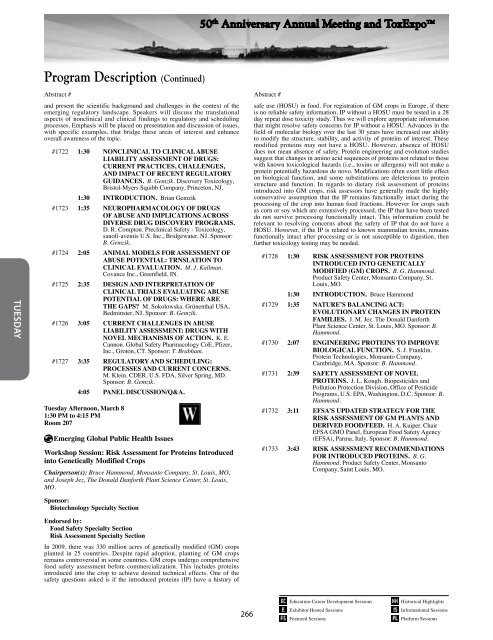Program - Society of Toxicology
Program - Society of Toxicology
Program - Society of Toxicology
Create successful ePaper yourself
Turn your PDF publications into a flip-book with our unique Google optimized e-Paper software.
50 th Anniversary Annual Meeting and ToxExpo<br />
<strong>Program</strong> Description (Continued)<br />
Tuesday<br />
Abstract # Abstract #<br />
and present the scientific background and challenges in the context <strong>of</strong> the<br />
emerging regulatory landscape. Speakers will discuss the translational<br />
aspects <strong>of</strong> nonclinical and clinical findings to regulatory and scheduling<br />
processes. Emphasis will be placed on presentation and discussion <strong>of</strong> issues,<br />
with specific examples, that bridge these areas <strong>of</strong> interest and enhance<br />
overall awareness <strong>of</strong> the topic.<br />
#1722 1:30 NONCLINICAL TO CLINICAL ABUSE<br />
LIABILITY ASSESSMENT OF DRUGS:<br />
CURRENT PRACTICES, CHALLENGES,<br />
AND IMPACT OF RECENT REGULATORY<br />
GUIDANCES. B. Gemzik. Discovery <strong>Toxicology</strong>,<br />
Bristol-Myers Squibb Company, Princeton, NJ.<br />
1:30 INTRODUCTION. Brian Gemzik<br />
#1723 1:35 NEUROPHARMACOLOGY OF DRUGS<br />
OF ABUSE AND IMPLICATIONS ACROSS<br />
DIVERSE DRUG DISCOVERY PROGRAMS. <br />
D. R. Compton. Preclinical Safety - <strong>Toxicology</strong>,<br />
san<strong>of</strong>i-aventis U.S. Inc., Bridgewater, NJ. Sponsor:<br />
B. Gemzik.<br />
#1724 2:05 ANIMAL MODELS FOR ASSESSMENT OF<br />
ABUSE POTENTIAL: TRNSLATION TO<br />
CLINICAL EVALUATION. M. J. Kallman.<br />
Covance Inc., Greenfield, IN.<br />
#1725 2:35 DESIGN AND INTERPRETATION OF<br />
CLINICAL TRIALS EVALUATING ABUSE<br />
POTENTIAL OF DRUGS: WHERE ARE<br />
THE GAPS? M. Sokolowska. Grünenthal USA,<br />
Bedminster, NJ. Sponsor: B. Gemzik.<br />
#1726 3:05 CURRENT CHALLENGES IN ABUSE<br />
LIABILITY ASSESSMENT: DRUGS WITH<br />
NOVEL MECHANISMS OF ACTION. K. E.<br />
Cannon. Global Safety Pharmacology CoE, Pfizer,<br />
Inc., Groton, CT. Sponsor: T. Brabham.<br />
#1727 3:35 REGULATORY AND SCHEDULING:<br />
PROCESSES AND CURRENT CONCERNS. <br />
M. Klein. CDER, U.S. FDA, Silver Spring, MD.<br />
Sponsor: B. Gemzik.<br />
4:05 PANEL DISCUSSION/Q&A.<br />
Tuesday Afternoon, March 8<br />
1:30 PM to 4:15 PM<br />
Room 207<br />
Emerging Global Public Health Issues<br />
Workshop Session: Risk Assessment for Proteins Introduced<br />
into Genetically Modified Crops<br />
Chairperson(s): Bruce Hammond, Monsanto Company, St. Louis, MO,<br />
and Joseph Jez, The Donald Danforth Plant Science Center, St. Louis,<br />
MO.<br />
safe use (HOSU) in food. For registration <strong>of</strong> GM crops in Europe, if there<br />
is no reliable safety information, IP without a HOSU must be tested in a 28<br />
day repeat dose toxicity study. Thus we will explore appropriate information<br />
that might resolve safety concerns for IP without a HOSU. Advances in the<br />
field <strong>of</strong> molecular biology over the last 30 years have increased our ability<br />
to modify the structure, stability, and activity <strong>of</strong> proteins <strong>of</strong> interest. These<br />
modified proteins may not have a HOSU. However, absence <strong>of</strong> HOSU<br />
does not mean absence <strong>of</strong> safety. Protein engineering and evolution studies<br />
suggest that changes in amino acid sequences <strong>of</strong> proteins not related to those<br />
with known toxicological hazards (i.e., toxins or allergens) will not make a<br />
protein potentially hazardous de novo. Modifications <strong>of</strong>ten exert little effect<br />
on biological function, and some substitutions are deleterious to protein<br />
structure and function. In regards to dietary risk assessment <strong>of</strong> proteins<br />
introduced into GM crops, risk assessors have generally made the highly<br />
conservative assumption that the IP remains functionally intact during the<br />
processing <strong>of</strong> the crop into human food fractions. However for crops such<br />
as corn or soy which are extensively processed, the IP that have been tested<br />
do not survive processing functionally intact. This information could be<br />
relevant to resolving concerns about the safety <strong>of</strong> IP that do not have a<br />
HOSU. However, if the IP is related to known mammalian toxins, remains<br />
functionally intact after processing or is not susceptible to digestion, then<br />
further toxicology testing may be needed.<br />
#1728 1:30 RISK ASSESSMENT FOR PROTEINS<br />
INTRODUCED INTO GENETICALLY<br />
MODIFIED (GM) CROPS. B. G. Hammond.<br />
Product Safety Center, Monsanto Company, St.<br />
Louis, MO.<br />
1:30 INTRODUCTION. Bruce Hammond<br />
#1729 1:35 NATURE’S BALANCING ACT:<br />
EVOLUTIONARY CHANGES IN PROTEIN<br />
FAMILIES. J. M. Jez. The Donald Danforth<br />
Plant Science Center, St. Louis, MO. Sponsor: B.<br />
Hammond.<br />
#1730 2:07 ENGINEERING PROTEINS TO IMPROVE<br />
BIOLOGICAL FUNCTION. S. J. Franklin.<br />
Protein Technologies, Monsanto Company,<br />
Cambridge, MA. Sponsor: B. Hammond.<br />
#1731 2:39 SAFETY ASSESSMENT OF NOVEL<br />
PROTEINS. J. L. Kough. Biopesticides and<br />
Pollution Protection Division, Office <strong>of</strong> Pesticide<br />
<strong>Program</strong>s, U.S. EPA, Washington, D.C. Sponsor: B.<br />
Hammond.<br />
#1732 3:11 EFSA’S UPDATED STRATEGY FOR THE<br />
RISK ASSESSMENT OF GM PLANTS AND<br />
DERIVED FOOD/FEED. H. A. Kuiper. Chair<br />
EFSA GMO Panel, European Food Safety Agency<br />
(EFSA), Parma, Italy. Sponsor: B. Hammond.<br />
#1733 3:43 RISK ASSESSMENT RECOMMENDATIONS<br />
FOR INTRODUCED PROTEINS. B. G.<br />
Hammond. Product Safety Center, Monsanto<br />
Company, Saint Louis, MO.<br />
Sponsor:<br />
Biotechnology Specialty Section<br />
Endorsed by:<br />
Food Safety Specialty Section<br />
Risk Assessment Specialty Section<br />
In 2009, there was 330 million acres <strong>of</strong> genetically modified (GM) crops<br />
planted in 25 countries. Despite rapid adoption, planting <strong>of</strong> GM crops<br />
remains controversial in some countries. GM crops undergo comprehensive<br />
food safety assessment before commercialization. This includes proteins<br />
introduced into the crop to achieve desired technical effects. One <strong>of</strong> the<br />
safety questions asked is if the introduced proteins (IP) have a history <strong>of</strong><br />
266<br />
Education-Career Development Sessions<br />
Exhibitor Hosted Sessions<br />
Featured Sessions<br />
Historical Highlights<br />
Informational Sessions<br />
Platform Sessions
















